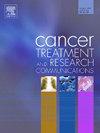Evaluation of the impact of energy, radiation type, and concentration on dose enhancement by Gold Nanoparticles
Q3 Medicine
引用次数: 0
Abstract
This study aimed to investigate the radiosensitization effects of Gold Nanoparticles (GNPs) on microscopic and macroscopic Dose Enhancement Ratios (DER) across various radiation energies and types, as well as different GNP concentrations. We utilized the OncoSeed 125I model with 6711 spectra, simulating linac megavoltage beams to irradiate GNP-loaded cells. Ten-nanometer GNPs filled small water cells (30 cm per side) in a cubic phantom, while additional 10 nm GNPs were placed in cubic voxels (0.1 × 0.1 × 0.1 µm3) centered in a 1 cm diameter cell, with concentrations ranging from 0 to 30 mg/g of Au were used to study the Dose Enhancement Factor (DEF). Both elastic and inelastic scattering mechanisms were included to accurately model low- and high-energy radiations. A monoenergetic beam of 50 keV targeted the GNP-loaded tumors, with interaction physics managed using data from the ENDF/BIII.1 file. Our findings revealed significant radiosensitization effects, particularly with low-energy and short-range electrons (<1 µm). DEF values ranged from 1 to 30 mg/g of gold under a 50 keV photon beam, resulting in dose increases of up to 2.29 for photons and 1.22 for electrons. We observed a 100 % reduction in DEF for electrons at the same energy and concentration, while higher ratios were noted for the linac photon beam. The modeled 125I seed produced a dose rate of 0.965 ± 0.002 cGy h-1 U-1, consistent with findings from the TG-43 report and existing literature. Increasing radiation energy significantly decreased DER, while higher GNP concentrations resulted in a dramatic increase. Further research on this topic is strongly encouraged.
评价能量、辐射类型和浓度对金纳米颗粒剂量增强的影响
本研究旨在探讨金纳米颗粒(GNPs)在不同辐射能量和类型以及不同GNP浓度下对微观和宏观剂量增强比(DER)的辐射增敏效应。我们使用具有6711光谱的OncoSeed 125I模型,模拟直线超电压光束照射gnp负载细胞。10纳米GNPs填充立方体幻影中的小水细胞(每侧30 cm),另外10纳米GNPs放置在立方体素(0.1 × 0.1 × 0.1µm3)中,以直径为1 cm的细胞为中心,浓度为0 ~ 30 mg/g的Au用于研究剂量增强因子(DEF)。包括弹性和非弹性散射机制,以准确地模拟低能和高能辐射。50 keV的单能束靶向gnp负载的肿瘤,使用来自ENDF/BIII的数据进行相互作用物理管理。1文件。我们的研究结果显示了显著的放射敏化效应,特别是低能和短程电子(<1µm)。在50 keV光子束下,黄金的DEF值从1到30毫克/克不等,导致光子的剂量增加高达2.29,电子的剂量增加高达1.22。我们观察到,在相同能量和浓度下,电子的DEF降低了100%,而直线光子束的DEF降低了更高的比率。模拟的125I种子产生的剂量率为0.965±0.002 cGy h-1 U-1,与TG-43报告和现有文献的结果一致。辐射能量的增加大大降低了DER,而GNP浓度的增加则导致DER的急剧增加。强烈鼓励对这一主题进行进一步研究。
本文章由计算机程序翻译,如有差异,请以英文原文为准。
求助全文
约1分钟内获得全文
求助全文
来源期刊

Cancer treatment and research communications
Medicine-Oncology
CiteScore
4.30
自引率
0.00%
发文量
148
审稿时长
56 days
期刊介绍:
Cancer Treatment and Research Communications is an international peer-reviewed publication dedicated to providing comprehensive basic, translational, and clinical oncology research. The journal is devoted to articles on detection, diagnosis, prevention, policy, and treatment of cancer and provides a global forum for the nurturing and development of future generations of oncology scientists. Cancer Treatment and Research Communications publishes comprehensive reviews and original studies describing various aspects of basic through clinical research of all tumor types. The journal also accepts clinical studies in oncology, with an emphasis on prospective early phase clinical trials. Specific areas of interest include basic, translational, and clinical research and mechanistic approaches; cancer biology; molecular carcinogenesis; genetics and genomics; stem cell and developmental biology; immunology; molecular and cellular oncology; systems biology; drug sensitivity and resistance; gene and antisense therapy; pathology, markers, and prognostic indicators; chemoprevention strategies; multimodality therapy; cancer policy; and integration of various approaches. Our mission is to be the premier source of relevant information through promoting excellence in research and facilitating the timely translation of that science to health care and clinical practice.
 求助内容:
求助内容: 应助结果提醒方式:
应助结果提醒方式:


